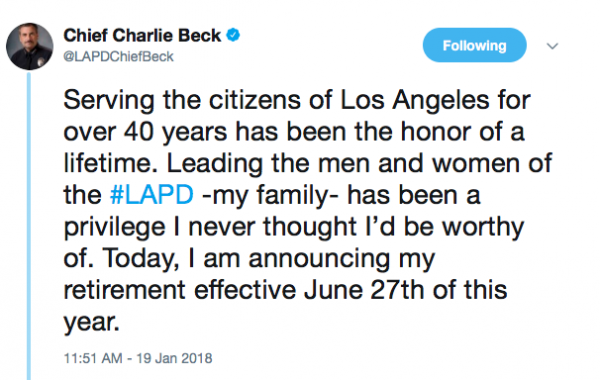In 2011, I went to the graduation of the Citizens Academy at LAPD. This is a 10-week academy the department offers to the community to familiarize citizens with how officers do their jobs.
This one was for the LGBTQ community, at the department’s training facility at Elysian Park. Entering, I passed a bust of former Chief Darryl Gates. I took a seat and watched the graduation. The valedictorian was a transgender woman, a student at Cal State Northridge. As she spoke, I was struck by the moment. It was an amazing thing, given all the department had been under the man whose statue stood a couple dozen y ards away.
ards away.
 ards away.
ards away. I remembered that moment when I heard the news that another L.A. police chief, Charlie Beck, had announced his retirement last week.
The tenure of any chief is complicated, especially in a complicated city like L.A., and crime ebbs and flows from year to year. But it’s important, at moments like these, I think, to reflect on the larger picture.
The LA Times noted Beck was leaving amid “a stubborn uptick in crime” – four years of crime rising. But truth is, that’s only when you’re marking time as having begun in the last few years. And that’s a very short-sighted view, pampered by the new reality, which is this: Crime in L.A. has fallen dramatically, in some cases to levels not seen since the 1960s.
We’re now in the eighth year of fewer than 300 killings. As of mid-December, Los Angeles had registered 271 killings in 2017. For 1967, when the city’s population was a quarter smaller, the city registered 281.
That’s a stunning feat. Even more so because it takes place in a city with a maelstrom of languages, cultures – from Nigeria and Bangladesh to Korea and Mexico – and neighborhoods, not to mention gaping economic differences, rising homelessness and more.
Crucial in all this and equally stunning: Gangs have largely stopped the public behavior that did so much to crush working-class neighborhoods. Families in those neighborhoods don’t face the risk to their children they once did. Business owners no longer have massive graffiti to paint over every month.
Homeowners in black and Latino neighborhoods are now able to unlock the value of their homes – in both sales and home-equity loans – in a way that was impossible a decade ago. Gangs, after all, were always the best rent control.
In several neighborhoods, it’s now fashionable to put up wood-slat fences. They look great, but when I saw the first one I thought it would be a matter of minutes before it was tagged in some way. I’ve seen those same fences unmarred for months now, years in a couple cases. Those wood-slat fences mark a major change of street culture for Los Angeles.
Gangs still exist in L.A. and are involved in criminal activity – though I believe they are far smaller in number than before. But their activity is no longer the public stuff — the drive-by shootings, car jackings, taking over a park or apartment complex etc – that so used to blight and create life-threatening danger in the places they called their territory.
A lot went into all these changes and it’s not all due to Beck or even to LAPD alone.
But the new department is one of the most transformed institutions in California civic life in the last 25 years, as that Citizens Academy graduation made clear. Spend time in any LAPD station watching the officers come and go and you’ll see this very clearly. I think it’s foolish, and short-sighted, to believe that that transformation had nothing to do with the current safe conditions in Los Angeles today.
Any department faces conflict, drama, willful personalities, and rogue officers. It’s a rough job and we ask police officers to be our marital counselors, mental health professionals, our surrogate fathers and mothers, and a whole lot more, as well as our crime fighters.
All that’s the day-to-day.
But when a chief announces his retirement, there are more important facts – and a longer view – to consider.


